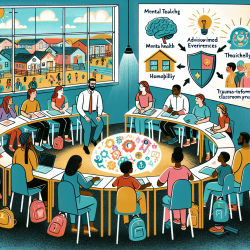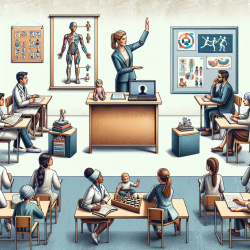Introduction
In the current educational landscape, the mental health and well-being of students are paramount, especially in the wake of adverse childhood experiences (ACEs) and global challenges like COVID-19. The research article "Homophily Effect in Trauma-Informed Classroom Training for School Personnel" provides valuable insights into how training can be optimized to support school personnel in creating trauma-informed environments. This blog post will explore the implications of the study's findings and how practitioners can apply these insights to enhance their skills and improve outcomes for children.
Understanding Homophily in Training
Homophily refers to the tendency of individuals to associate and bond with similar others. In the context of trauma-informed classroom (TIC) training, homophily can influence how school personnel perceive and internalize training content. The study conducted by Zickafoose et al. (2022) examined whether the similarity between trainers and trainees (homophily) affected participants' knowledge and perceptions of TIC training.
Key Findings
- The study found no significant differences in the effectiveness of TIC training delivered by homophilous peers (school staff) versus heterophilous experts (mental health professionals).
- Both peer and expert trainers were equally effective in conveying TIC practices, suggesting that the train-the-trainer model is a viable approach for disseminating TIC knowledge.
- Participants' perceptions of trauma's effects on learning improved post-training, indicating the lasting impact of TIC training on school personnel.
Implications for Practitioners
For practitioners aiming to improve their skills in trauma-informed practices, the study highlights several key takeaways:
- Embrace the Train-the-Trainer Model: Given the effectiveness of both peer and expert trainers, practitioners can leverage the train-the-trainer model to rapidly disseminate TIC practices within their schools.
- Focus on Long-Term Perception Changes: Training should aim not only to increase immediate knowledge but also to foster long-term changes in perceptions and attitudes towards trauma-informed practices.
- Continuous Practice and Feedback: Incorporating opportunities for practice and feedback during training sessions can enhance the retention and application of TIC techniques.
Encouraging Further Research
While the study provides valuable insights, it also opens avenues for further research. Practitioners are encouraged to explore the following areas:
- Investigate the specific elements of TIC training that contribute most to long-term changes in perceptions and practices.
- Examine the impact of TIC training on student outcomes and classroom environments.
- Explore the role of cultural and contextual factors in the effectiveness of TIC training.
Conclusion
Trauma-informed classroom training is essential for equipping school personnel to support students affected by ACEs and other traumas. By understanding and applying the principles of homophily, practitioners can enhance their training efforts and create more supportive learning environments. To delve deeper into the research findings, I encourage you to read the original research paper: Homophily Effect in Trauma-Informed Classroom Training for School Personnel.










